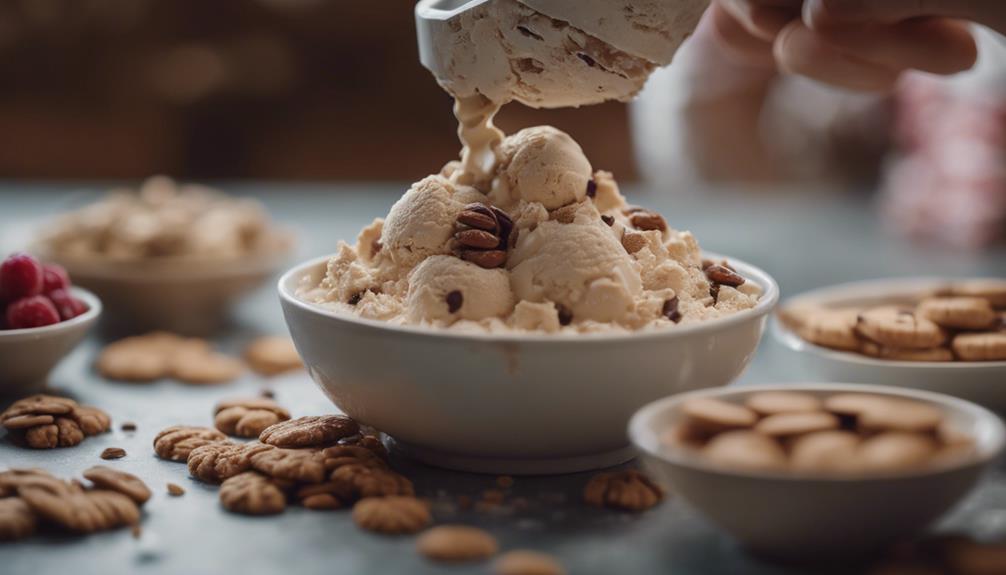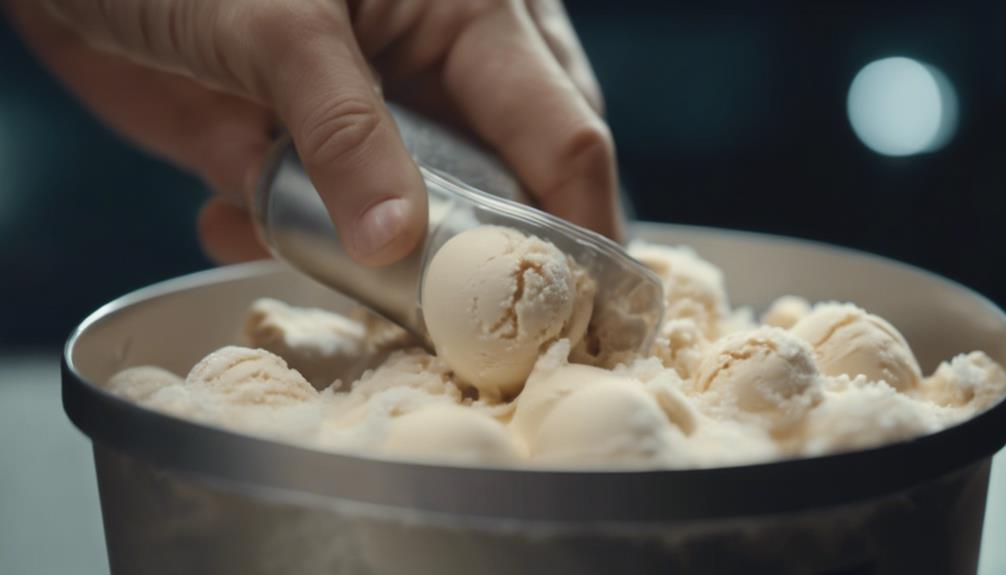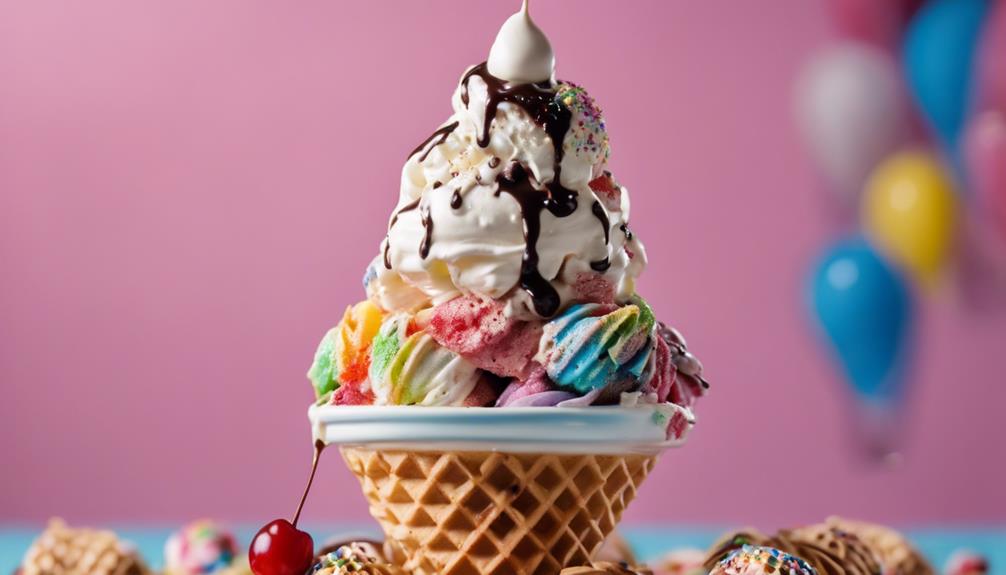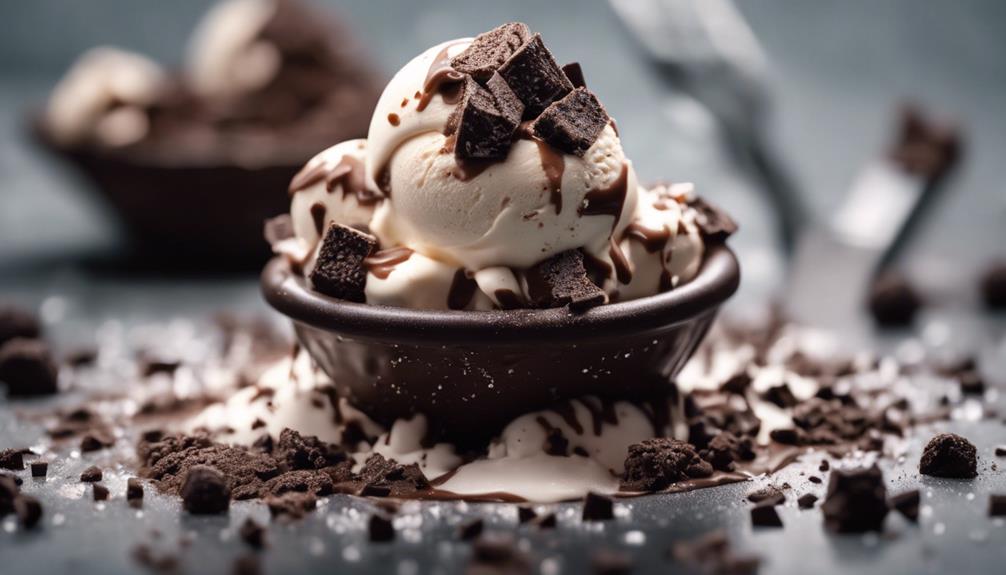If your ice cream has a gritty taste, ensure a smooth treat with some easy tips. Examine your add-ins, such as nuts or candies, as they may be the cause of the grainy texture. Layer your add-ins thoughtfully to minimize grittiness. Choose homemade add-ins over store-bought alternatives for a smoother result. Keep in mind, with a few tweaks, you can savor a creamy delight every time.
Key Takeaways
- Use homemade add-ins for smoother texture.
- Layer add-ins carefully to prevent grittiness.
- Opt for smaller batches for even churning.
- Swiftly freeze churned ice cream to avoid crystal formation.
- Re-churn ice cream to break down existing crystals.
Common Ice Cream Texture Issues

Experiencing common ice cream texture issues, such as gritty textures, can be frustrating when enjoying your frozen treat. Grittiness often occurs due to the formation of large ice crystals during the freezing process. When the ice cream mix is rapidly frozen, these crystals can grow bigger, resulting in a gritty mouthfeel. To combat this, it's essential to chill the ice cream mix adequately before churning. Proper chilling helps in controlling ice crystal formation, leading to a smoother texture.
In homemade ice cream, using add-ins can also contribute to grittiness if not handled correctly. Add-ins like nuts, cookies, or candies may become gritty if they aren't prepared appropriately. One way to reduce grittiness when incorporating add-ins is to layer them carefully into the ice cream. Additionally, using homemade add-ins instead of store-bought options can help maintain a smoother texture.
Recipe Preparation Tips for Balance

Accurately measuring your ingredients is essential for achieving a well-balanced ice cream recipe. To make sure a smooth texture, follow balanced recipes from reputable sources.
Proper mixing of stabilizers is vital to prevent clumping and ensure a creamy consistency. Experimenting with lower sugar or fat levels can change the size of ice crystals and enhance the overall mouthfeel of your ice cream.
When preparing your recipe, consistency is key. Make sure to follow the instructions accurately each time to achieve the desired smoothness.
Cooling and Freezing Best Practices

Pre-freezing the ice cream maker bowl for at least 24 hours is essential for ensuring proper chilling.
Before churning, make sure to chill the ice cream mixture adequately to promote a smoother texture.
Once the ice cream is churned, swiftly transfer it to the freezer to prevent ice crystal formation, maintaining a creamy consistency.
Utilizing high-quality ingredients and stabilizers can further enhance the creaminess of your ice cream while preventing any gritty textures.
Be cautious not to over-churn the ice cream, as this can result in the unwanted formation of fat globules, leading to a less desirable texture.
Consistency and Air Content Adjustment

To enhance the texture and creaminess of your homemade ice cream, consider adjusting the fat and sugar levels for best consistency. The amount of fat and sugar in your ice cream recipe directly impacts its hardness and overall texture.
Additionally, increasing the air content during churning can notably improve the smoothness of your ice cream. Balancing the air content is essential to achieving a creamy texture without compromising the taste.
Homemade ice cream tends to be harder than store-bought varieties because it usually contains less air. This lower air content affects the texture, making it denser and potentially grittier.
By adjusting your churning technique to incorporate more air, you can create a smoother and creamier ice cream consistency.
If your ice cream turns out too hard, you can try softening it by letting it sit out of the freezer for a few minutes before scooping. This simple step can help improve the consistency and make your homemade treat more enjoyable.
Maintaining Texture and Flavor

To maintain the texture and flavor of your ice cream, you must carefully balance the fat, sugar, and air content. These elements play an important role in ensuring a smooth and enjoyable ice cream experience.
Adjustments in fat and sugar levels can greatly impact the overall flavor profile of your homemade treat.
Texture Balance Importance
Achieving the ideal balance of fat, sugar, and air content is essential for ensuring a smooth texture and excellent flavor in your homemade ice cream. Here are some key points to keep in mind when focusing on the importance of texture balance:
- Fat Content: Controlling the amount of fat in your ice cream recipe impacts the richness and creaminess of the final product.
- Sugar Levels: Balancing the sugar content is vital for sweetness and softness, as it affects the freezing point of the ice cream.
- Air Incorporation: Properly integrating air during the churning process contributes to the lightness and fluffiness of the ice cream.
- Consistency in Recipes: Following a consistent recipe helps maintain the desired smooth texture and flavor profile.
- Ingredient Experimentation: Trying out different ingredients can lead to exciting variations in texture and flavor, allowing for creative exploration in homemade ice cream making.
Flavor Impact Consideration
Maintaining a well-balanced flavor profile is just as important as achieving the ideal texture in homemade ice cream. When considering the flavor impact of your ice cream, understanding how ingredients like fat and sugar play a significant role not only in taste but also in texture is crucial. Balancing these components can result in a smooth and decadent final product. Experimenting with different ingredients can lead to unique flavor profiles, but consistency is key to maintaining the desired texture and taste. Here is a table to help you visualize the relationship between flavor impact, fat, sugar, texture, and ingredients:
| Flavor Impact | Fat | Sugar | Texture | Ingredients |
|---|---|---|---|---|
| Balances | High | High | Creamy | Traditional |
| Enhanced | Low | High | Smooth | Natural |
| Varied | High | Low | Light | Experimental |
| Intense | High | High | Rich | Premium |
| Subtle | Low | Low | Fluffy | Artisanal |
Improving Ice Cream Texture Techniques

Enhance the texture of your ice cream by implementing proper churning and cooling techniques. When dealing with gritty ice cream, consider the following techniques to improve its texture:
- Thorough Churning: Guarantee complete churning of your ice cream to prevent the formation of large ice crystals that contribute to a gritty texture.
- Proper Cooling: Rapidly chill your ice cream mixture to inhibit ice crystal growth, resulting in a smoother texture.
- Re-Churning: Soften gritty ice cream and re-churn it to break down existing ice crystals and create a creamier consistency.
- Small Batches: Opt for smaller batches when making ice cream to facilitate even churning and prevent gritty textures.
- Granita Transformation: Transform gritty ice cream into a granita by scraping it with a fork, providing a unique texture experience while salvaging the batch.
Understanding Fat Globules in Ice Cream

When making ice cream, understanding how fat globules form and how to prevent fat separation is vital.
Over-churning can lead to large fat globules, resulting in a gritty texture that affects your dessert's quality.
Fat Globule Formation
Understanding the formation of fat globules in ice cream is crucial for achieving a smooth and creamy texture. Here are some key points to keep in mind:
- Fat globules in ice cream can form when the fat molecules clump together during the churning process.
- Over-churning the ice cream can lead to the creation of large fat globules, affecting the texture.
- Emulsifying the ice cream mix while warm can help prevent the formation of fat globules.
- Proper monitoring of the churning process is essential to prevent fat separation and maintain a smooth texture.
- Understanding the role of fat globules in ice cream can help enhance the overall quality of the final product.
Preventing Fat Separation
To prevent fat separation in ice cream, make sure that the churning process is carefully monitored to avoid the formation of gritty fat globules. Over-churning can lead to fat chunks forming, resulting in a less smooth texture. Emulsifying the ice cream mix while warm helps stabilize the fat globules and prevent separation during churning. Consistently monitoring the consistency of the ice cream as it churns is crucial to ensure that the fat globules are properly emulsified and distributed evenly. Avoiding over-churning is key to maintaining the emulsification of the fat globules and preventing gritty textures in your ice cream. Follow the manufacturer's guidelines for churning times, but be prepared to adjust as needed to prevent fat separation issues.
| Key Points | Details |
|---|---|
| Over-churning | Leads to the formation of fat globules causing a gritty texture. |
| Emulsifying | Helps stabilize fat globules and prevent separation during churning. |
| Monitoring consistency | Crucial to ensure proper emulsification and even distribution of fat. |
| Prevent separation | Avoid over-churning to maintain emulsification and prevent gritty textures. |
| Adjust churning time | Follow guidelines but adjust as needed to prevent fat separation issues. |
Addressing Icy or Gritty Add-Ins

Dealing with icy or gritty add-ins in your ice cream can be resolved by adjusting their composition and preparation techniques. When facing this issue, consider the following tips:
- Store-bought add-ins: Check the composition of store-bought add-ins as they may contain ingredients that freeze poorly in ice cream.
- Homemade add-ins: Opt for homemade add-ins that can be customized to freeze better with your ice cream.
- Add oil to chocolate coatings: Prevent chocolate coatings from becoming too hard by integrating oil into the recipe.
- Cool variegates: Make sure variegates are completely cooled before adding them to the ice cream to maintain a smooth texture.
- Layer add-ins carefully: Prevent the formation of ice crystals by layering add-ins thoughtfully within the ice cream mixture.
Ice Cream Storage Strategies

Consider storing your homemade ice cream in airtight containers to maintain its smooth texture and prevent the formation of ice crystals.
When storing, place a piece of wax paper directly on the ice cream's surface before sealing the container. This step helps minimize freezer burn, ensuring your ice cream stays delicious.
Avoid storing your ice cream near the freezer door to prevent temperature fluctuations that can negatively impact its texture.
To thaw your ice cream properly, transfer it to the refrigerator. This method helps maintain the best texture by avoiding rapid temperature changes that can lead to grittiness.
Remember to keep your ice cream at a consistent temperature in the coldest part of the freezer to preserve its smoothness.
Frequently Asked Questions
How Do You Make Grainy Ice Cream Smooth?
To make grainy ice cream smooth, soften it slightly and re-churn to break large crystals. Add corn syrup for texture, or use xanthan gum to prevent crystals. Process in a food processor or turn into a granita for a different texture.
Why Does My Ice Cream Taste Grainy?
When your ice cream tastes grainy, it's likely due to ice crystal formation during freezing or improper churning techniques. Large crystals or inadequate freezing can result in a sandy texture. Adjusting churning methods or recipe components may help improve texture.
How Do You Fix Sandy Ice Cream?
When your ice cream feels like a beach, adjust freezing time, temper the mix before churning, add stabilizers, and guarantee thorough mixing. Follow these steps to smooth out the grit and savor a creamy delight.
How Do You Make Ice Cream Smooth Again?
To make ice cream smooth again, thaw it slightly, then re-churn in a food processor. This process breaks down ice crystals, creating a creamier texture. You'll enjoy a smoother treat in no time with this simple trick!
Is a Gritty Ice Cream Taste Related to the Condition of the Ice Cream Scoop?
When it comes to the gritty texture of your ice cream, the condition of your ice cream scoop could be the culprit. A clean zeroll ice cream scoop ensures a smooth and creamy scoop every time, while a dirty or damaged scoop could result in a less-than-ideal texture.
Can Cleaning my Zeroll Ice Cream Scoop Help Prevent Gritty Ice Cream?
Regularly cleaning zeroll ice cream scoop tips can help prevent gritty ice cream. By keeping the scoop clean, you can avoid any build-up of residue or dirt that could affect the texture of your dessert. Use warm water and a soft cloth to clean your Zeroll scoop after each use.
Conclusion
To sum up, by following these tips and techniques for improving ice cream texture, you can guarantee a smooth and creamy treat every time.
From recipe adjustments to proper storage, maintaining balance and consistency is crucial.
By understanding the science behind fat globules and addressing coarse add-ins, you can elevate your homemade ice cream game.
So next time your ice cream tastes gritty, don't lose hope – apply these strategies for a deliciously smooth success!
















